University of Groningen
| Rijksuniversiteit Groningen (RUG) | |
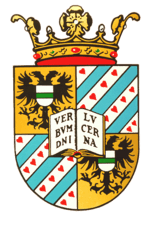 | |
| Latin: Academia Groningana | |
| Motto | Verbum Domini lucerna pedibus nostris |
|---|---|
Motto in English | "The word of the Lord is a light for our feet" |
| Type | Public research university |
| Established | 1614 |
| President | Prof. Sibrand Poppema[1] |
| Rector | Prof. Elmer Sterken[2] |
Academic staff | 5,608 employees |
| Students | 30,041 |
| Postgraduates | 1,758 |
| Location |
Groningen, Netherlands 53°13′9″N 6°33′46″E / 53.21917°N 6.56278°ECoordinates: 53°13′9″N 6°33′46″E / 53.21917°N 6.56278°E |
| Colors | Traffic red |
| Website |
www |
 | |
The University of Groningen (abbreviated as UG;[3] Dutch: Rijksuniversiteit Groningen, abbreviated as RUG) is a public research university in the city of Groningen in the Netherlands. The university was founded in 1614 and is one of the oldest universities in the Netherlands as well as one of its largest. Since its inception more than 200,000 students have graduated. It is a member of the distinguished international Coimbra Group of European universities.
In April 2013, according to the results of the International Student Barometer, the University of Groningen, for the third time in a row, has been voted the best university of the Netherlands.[4] In 2014 the university celebrated its 400th anniversary.[5]
The University of Groningen has ten faculties, nine graduate schools, 27 research centres and institutes, and more than 175 degree programmes.
History
.jpg)
The founding of the University in 1614 – at that time still a college of higher education – was an initiative taken by the Regional Assembly of the city of Groningen and the Ommelanden, or surrounding region. There were four faculties – Theology, Law, Medicine, and Philosophy.[6][7][8]
The coat of arms of the university was confirmed by the States of the City and County of Groningen in 1615. It consists of the provincial arms, charged with an open book inscribed with the abbreviated words VER/BVM/DNI LV/CER/NA, short for Verbum Domini Lucerna Pedibus Nostris. The shield is surmounted by a golden crown of five leaves and four pearls.
The first 75 years of its existence were very fruitful for the University with about 100 students enrolling every year. Almost half of the students and lecturers came from outside the Netherlands – the first Rector Magnificus, Ubbo Emmius, came from East Frisia in modern-day Germany, for instance – but at the same time there was already a close relationship between the University and the city and the surrounding region.
The development of the University came to a standstill at the end of the seventeenth and during the eighteenth century because of theological differences of opinion, a difficult relationship with the Regional Assembly and political problems that included the siege of the city by ‘Bommen Berend’ in 1672. On average two to three hundred students were registered with the University at any one time during this period. Petrus Camper, though, was a shining academic example during the second half of the eighteenth century and was famous far beyond the city limits as an anatomist, a fighter against rinderpest and the founder of the first outpatient’s clinic for surgical medicine.

Opportunities and threats followed on each other’s heels during the nineteenth century. In 1815, at the same time as Leiden and Utrecht, the University gained recognition as a national college of higher education, but this was followed by discussions about closure. The situation improved markedly when a new main university building, the Academiegebouw, was constructed in 1850, a building that was largely financed by the people of Groningen. This made the fire that completely destroyed this building in 1906 even more poignant.
In the meantime, the Higher Education Act of 1876 had radically improved the position of the University, which was renamed the "Rijksuniversiteit Groningen" (RUG). Teaching now took place in Dutch as well as in Latin and the University was given a research as well as an educational duty. This laid the foundations for the present research university.
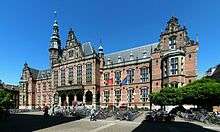
The University of Groningen developed apace during the first decades of the twentieth century. The number of faculties and courses grew steadily while the number of students showed an explosive growth. When the University celebrated its first 300 years in 1914 there were 611 registered students; this had already grown to 1000 by 1924. After a drop back during the Depression, and in particular during the Second World War, the number of students grew rapidly from 1945 to reach 20,000 in 1994. At the present time there are about 30,000 students registered at the University of Groningen with the number of foreign students again growing steadily, and following the tradition set by the first Rector Magnificus, the number of German students and researchers has grown strongly in recent years.
In 2016 the Dutch chemist Ben Feringa, who has spent most of his career at the University of Groningen, won the Nobel prize for his work on molecular motors.[9]
Facts and figures
| University rankings | |
|---|---|
| Global | |
| ARWU[10] | 75 |
| Times[11] | 74 |
| QS[12] | 90 |
| Europe | |
| Times[13] | 27 |
| QS[14] | 35 |
Key facts and figures about the University of Groningen are:[15]
- 30,000 students (incl. 3750 international students)
- 6,213 first-year students (10,3% share of Dutch market)
- 48% of the 1,500 PhD students are international
- 6,500 employees (almost 20% international)
- 498 professors, 69 associate professors, 92 professors by special appointment (including University Medical Center Groningen, UMCG)
- 49 bachelor's and 146 master's degree programmes
- 19 bachelor's degree programmes are taught in English
- 101 master's degree programmes (of which 10 double degree programmes) are taught in English
- 16 research master's programmes
- 10 faculties, 9 graduate schools
- 597 mln euro annual turnover
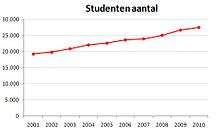
The University of Groningen is in the top 3 of European research universities in the fields of: Ecology, Material Sciences, Chemistry and Astronomy. Other strong research groups are in: Nanoscience, Physics, Molecular Biology, Microbiology, Medical Sciences, Neurosciences, Sociology, Philosophy, Theology, Archaeology and Arts. Every year more than 5,000 research publications go to print and an average of 260 PhD students are awarded their PhD degree.
- The University of Groningen is a member of the so-called Excellence Group of the best universities in Europe. The Excellence Group has 56 members, which is 1.3 percent of the approximately 4,500 European institutions of higher education.[16]
- The University of Groningen belongs to the top 100 large comprehensive research universities in the world.[17]
- In 2015–2016, the University of Groningen ranked 74th in the Times Higher Education World University Rankings.[18]
- The University of Groningen is worldwide on shared position 72 of the Academic Ranking of World Universities (ARWU). ARWU is a global Top 500 published annually by the Shanghai Jiao Tong University.[19]
- The University was ranked 75th in the world in 2012 by the National Taiwan University that publishes the Performance Ranking of Scientific Papers for World Universities.[20]
- Groningen was internationally ranked by QS World University Rankings,[21] and gained the position of 97th (2013).[22]
- The University of Groningen holds the 18th position in the European ranking (94th wordwide) of Webometrics.[23]
- The University of Groningen has its own newspaper: the Universiteitskrant.[24]
The university's Center for Information Technology (CIT) houses an IBM Blue Gene/L supercomputer and data center of Target used by the LOFAR project as well as a Virtual Reality and 3D-visualisation center.[25]
Faculties
.jpg)
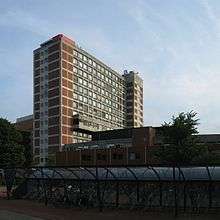
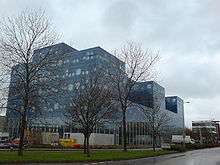
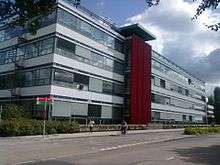
The University of Groningen is organized in ten faculties that offer programmes and courses in the fields of humanities, social sciences, law, economics and business, spatial sciences, life sciences, and natural sciences and technology. Each faculty (cf., College in the USA or School in Europe) is a formal grouping of academic degree programmes, schools and institutes, discipline areas, research centres, and/or any combination of these drawn together for educational purposes. Each faculty offers Bachelor's, Master's, PhD, and Exchange programmes, while some also offer short certificate courses.
- Faculty of Economics and Business[26]
- Faculty of Arts[27]
- Faculty of Law[28]
- Faculty of Theology and Religious Studies[29]
- Faculty of Philosophy[30]
- Faculty of Behavioural and Social Sciences[31]
- Faculty of Medical Sciences[32]
- Faculty of Science and Engineering[33] (named Faculty of Mathematics and Natural Sciences until 1 February 2017)
- Faculty of Spatial Sciences[34]
- University College Groningen[35]
Degree programmes
Research
Research schools, centres and institutes
Humanities and Social Sciences
- Center for Language and Cognition Groningen (CLCG)
- Globalisation Studies Groningen (GSG)
- Centre for Religious Studies (CRS)
- Groningen Institute of Archeology (GIA)
- Groningen Institute for Educational research (GION)
- Groningen Research Institute of Philosophy (GRIPH)
- Groningen Research Institute for the Study of Culture (ICOG)
- Heymans Institute
- Interuniversity Center for Social Science Theory and Methodology (ICS)
- Urban and Regional Studies Institute (URSI)
Law
- Centre for Law, Administration and Society (CRBS)
- Groningen Centre of Energy Law (GCEL)
Economics & Business
- Economics, Econometrics and Finance (EEF)
- Global Economics and Management (GEM)
- Human Resource Management & Organisational Behaviour (HRM-OB)
- Innovation & Organization (IO)
- Marketing
- Operations Management & Operations Research (OPERA)
Life Sciences
- Research School of Behavioral and Cognitive Sciences (BCN) / UMCG[36]
- Research Institute BCN-BRAIN / UMCG[37]
- Cancer Research Center Groningen (CRCG) / UMCG[38]
- Groningen Institute for Evolutionary Life Sciences (GELIFES)[39]
- Groningen University Institute for Drug Exploration (GUIDE) / UMCG[40]
- Groningen Biomolecular Sciences and Biotechnology (GBB)
- Groningen Research Institute of Pharmacy (GRIP)
- Research Institute SHARE / UMCG[41]
- W.J. Kolff Institute for Biomedical Engineering and Materials Science / UMCG[42]
Science & Technology
- Artificial Intelligence and Cognitive Engineering (ALICE)[43]
- Center for Energy and Environmental Studies (IVEM)
- Centre for Isotope Research (CIO)
- Centre for Systems Chemistry
- Centre for Theoretical Physics
- Institute of Mathematics and Computing Science (IWI)
- Kapteyn Astronomical Institute
- Nuclear-physics Accelerator Institute (KVI)
- Stratingh Institute for Chemistry
- Zernike Institute for Advanced Materials[44]
Graduate schools
The University of Groningen’s Graduate Schools are organized somewhat different from its international counterparts.[45] The main difference is that the Graduate Schools do not contain all Master’s programmes; Graduate Schools manage and facilitate the two-year Master's programmes: top master's degree programmes and Research master's degree programmes.
- Graduate School of Behavioural and Social Sciences[46]
- Graduate School of Economics and Business[47]
- Graduate School of Humanities[48]
- Graduate School of Law[49]
- Graduate School of Medical Sciences[50]
- Graduate School of Philosophy[51]
- Graduate School of Science[52]
- Graduate School of Spatial Sciences[53]
- Graduate School of Theology and Religious Studies[54]
Notable alumni
Notable alumni of the University of Groningen include:[55]
- Johann Heinrich Alting, theologian
- Gerbrand Bakker, early 19th century physician
- Johann Bernoulli, mathematician
- Bart Bok, astronomer
- Anita Buma, Antarctic researcher in marine ecophysiology
- James Burnett
- Job Cohen, former mayor of Amsterdam and former leader of the Dutch Labour Party
- Willem de Sitter, astronomer
- Wim Duisenberg, first president of the European Central Bank in Frankfurt studied at UG and obtained his PhD on the economics of disarmament
- Ubbo Emmius, founder of the University of Groningen and first rector magnificus
- Zabih Etemadi, footballer who is leveraging law in football
- Ben Feringa, Nobel Prize in Chemistry in 2016 for his work on molecular motors, professor of Chemistry
- Pim Fortuyn, lecturer, later politician and founder of the Pim Fortuyn List (and assassinated in 2002)
- Willem Frederik Hermans, lecturer and writer
- Gerardus Heymans, philosopher and psychologist
- Pieter Hofstede Crull, jurist, attorney-general of Suriname and acting governor
- Peter Hofstee, professor of theoretical physics, joined IBM in 1996, currently the chief architect of the Synergistic Processor Element (SPE) of the Cell microprocessor.
- Johan Huizinga, historian
- Aletta Jacobs, first woman in the Netherlands to receive a MD
- Klaas Knot, current President of the Dutch central bank De Nederlandsche Bank (DNB).[56]
- Jaap Kunst, ethnomusicologist (studied law)
- Maurits van Oranje Nassau
- John Nerbonne, professor of humanities computing, expert in dialectology, member of the Dutch Royal Academy of Science
- Wubbo Ockels, first Dutch astronaut, received a PhD degree in physics and mathematics, 1973
- Heike Kamerlingh Onnes, received the Nobel Prize in Physics for his experiments on the properties of matter at low temperatures which made, among other things, the production of liquid helium possible
- Jan Oort, astronomer
- Johannes Jacobus Poortman, philosopher, psychologist
- Dagmar Reichardt, professor of Cultural Industry at University of Latvia
- Edgars Rinkevics, Minister of Foreign Affairs of the Republic of Latvia
- Henk G. Sol, Professor Business Engineering and ICT
- Dirk Stikker, secretary general of NATO
- Pieter Jelles Troelstra, lawyer, politician (early 20th century)
- Hans van Abeelen, first Dutch behavior geneticist
- Johan van Benthem, logician
- Wietse Venema, programmer and physicist
- Clemens von Bönninghausen, lawyer, botanist, homeopathic physician
- Jacques Wallage, former mayor of Groningen
- Paramanga Ernest Yonli, Prime Minister of Burkina Faso (2000–2007), studied Economics
- Frits Zernike, professor of theoretical physics, received the Nobel Prize in Physics for his invention of the phase contrast optical microscope in 1953
See also
References
- ↑ Carlien Bootsma, "Opnieuw werknemer RUG op non-actief" (in Dutch), Dagblad van het Noorden, 2016. Retrieved 19 April 2016.
- ↑ Patriecia Koltho, "RUG wil meer diversiteit onder hoogleraren" (in Dutch), Dagblad van het Noorden, 2016. Retrieved 19 April 2016.
- ↑ "Rug wordt 'joedzjie'". Universiteitskrant. Retrieved 19 April 2016.
- ↑ International Student Barometer: University of Groningen nr. 1 in the Netherlands! (Press release)
- ↑ University of Groningen turns 400! (website)
- ↑ Article published in The Independent, a major British newspaper, in 2011; accessed on 11 July 2017
- ↑ Archive of former Radio Netherlands Worldwide; accessed on 11 July 2017
- ↑ Article in U.S. News & World Report; accessed on 11 July 2017
- ↑ The Nobel Prize in Chemistry 2016, webpage at the Nobel Prize organization; accessed on 11 July 2017
- ↑ "Academic Ranking of World Universities 2017". Institute of Higher Education, Shanghai Jiao Tong University. 2017. Retrieved August 17, 2017.
- ↑ "World University Rankings 2016-2017". Times Higher Education. 2016. Retrieved October 22, 2016.
- ↑ "QS World University Rankings 2018". Quacquarelli Symonds Limited. 2017. Retrieved June 21, 2017.
- ↑ "Best universities in Europe 2017". The Times Higher Education. 2016. Retrieved October 22, 2016.
- ↑ "QS World University Rankings". QS Quacquarelli Symonds Limited. 2017. Retrieved June 17, 2017.
- ↑ "Kerncijfers". Retrieved 31 May 2015.
- ↑ "CHE ranking (2010)". Retrieved 31 May 2015.
- ↑ "Internationale positie". Retrieved 31 May 2015.
- ↑ "University of Groningen World University Rankings | THE". The Times Higher Educational Supplement. 2015. Retrieved 2016-09-10.
- ↑ "Academic Ranking of World Universities 2016". Shanghai Jiao Tong University. 2016. Retrieved 2016-09-10.
- ↑ "No data records!". Archived from the original on 21 September 2013. Retrieved 31 May 2015.
- ↑ "University of Groningen Rankings". Top Universities. Retrieved 31 May 2015.
- ↑ QS World University Rankings
- ↑ "Europe". Retrieved 31 May 2015.
- ↑ "UK". UK. Retrieved 31 May 2015.
- ↑ "The Cave". Retrieved 31 May 2015.
- ↑ Faculty of Economics and Business, University of Groningen. Retrieved 19 April 2016.
- ↑ Faculty of Arts, University of Groningen. Retrieved 19 April 2016.
- ↑ Faculty of Law, University of Groningen. Retrieved 19 April 2016.
- ↑ Faculty of Theology and Religious Studies, University of Groningen. Retrieved 19 April 2016.
- ↑ Faculty of Philosophy, University of Groningen. Retrieved 19 April 2016.
- ↑ Faculty of Behavioural and Social Sciences, University of Groningen. Retrieved 19 April 2016.
- ↑ Faculty of Medical Sciences, University of Groningen. Retrieved 19 April 2016.
- ↑ Faculty of Science and Engineering, University of Groningen. Retrieved 6 February 2017.
- ↑ Faculty of Spatial Sciences, University of Groningen. Retrieved 19 April 2016.
- ↑ University College Groningen, University of Groningen. Retrieved 19 April 2016.
- ↑ Research School of Behavioral and Cognitive Sciences (BCN), University of Groningen.
- ↑ Research Institute BCN-BRAIN, University of Groningen.
- ↑ Cancer Research Center Groningen (CRCG), University of Groningen.
- ↑ Groningen Institute for Evolutionary Life Sciences (GELIFES), University of Groningen.
- ↑ Groningen University Institute for Drug Exploration (GUIDE), University of Groningen.
- ↑ Research Institute SHARE, University of Groningen.
- ↑ W.J. Kolff Institute for Biomedical Engineering and Materials Science, University of Groningen.
- ↑ "institute for Artificial Intelligence & Cognitive Engineering". Retrieved 30 June 2016.
- ↑ "The Zernike Institute for Advanced Materials". Retrieved 31 May 2015.
- ↑ "PhD programma's". Retrieved 31 May 2015.
- ↑ "Graduate School of Behavioural and Social Sciences". Retrieved 31 May 2015.
- ↑ "Graduate School of Economics and Business". Retrieved 31 May 2015.
- ↑ "Graduate School for the Humanities". Retrieved 31 May 2015.
- ↑ "Graduate School of Law". Retrieved 31 May 2015.
- ↑ "Graduate School of Medical Sciences". Retrieved 31 May 2015.
- ↑ "Graduate School of Philosophy". Retrieved 31 May 2015.
- ↑ "Graduate School of Science". Retrieved 31 May 2015.
- ↑ "Graduate School of Spatial Sciences". Retrieved 31 May 2015.
- ↑ "Graduate School of Theology and Religious Studies". Retrieved 31 May 2015.
- ↑ "Prominente Groningse hoogleraren". Retrieved 31 May 2015.
- ↑ Klaas Knot wordt nieuwe president van DNB NU.nl
Further reading
- (in Dutch) Klaas van Berkel: Universiteit van het Noorden. Vier eeuwen academisch leven in Groningen. Part 1 De oude universiteit 1614-1876. Hilversum, Verloren, 2014. ISBN 978-90-8704-466-4
External links
| Wikimedia Commons has media related to University of Groningen. |